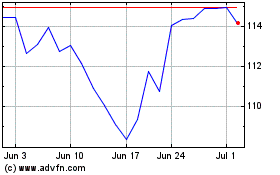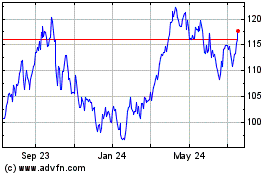By Karen Langley
The Dow Jones Industrial Average's coming farewell to Exxon
Mobil Corp. is the latest sign of the waning influence of America's
struggling energy sector.
When trading begins next week, the blue-chip benchmark will
include only one energy stock: Chevron Corp., which will represent
just 2.1% of the price-weighted index, according to an S&P Dow
Jones Indices analysis.
In the broader S&P 500, the group isn't faring much better:
Its weighting has shrunk to less than 2.5%, leaving energy as the
least influential of the 11 represented industries. That is a
dramatic fall from the end of 2011, when energy stocks accounted
for 12% of the market, according to Howard Silverblatt, senior
index analyst at S&P Dow Jones Indices.
Although the removal from the Dow is largely symbolic -- much
less money tracks the 30-stock index than follows the S&P 500
-- Exxon's departure has historical significance. The company is
the longest-tenured member of the benchmark, having joined in 1928
as Standard Oil of New Jersey.
It is also a reminder of Exxon's fall from the top echelon of
American industry. As recently as 2013, Exxon was the largest U.S.
company with a market value above $415 billion. It has since shrunk
to less than $180 billion and has been eclipsed by the technology
giants such as Apple Inc., Amazon.com Inc. and Microsoft Corp. that
now drive the American economy.
"Exxon, that used to be a behemoth in the U.S. markets, and now
it's dropped out of the Dow," said Matt Hanna, portfolio manager at
Summit Global Investments. "That just goes to show how quick things
can change and how far energy has fallen as a sector."
Usually, market contrarians say a sector that is so beaten down
should be ripe for bargains. But many investors remain skeptical of
an energy rebound, pointing to muted expectations for global growth
and spotty earnings.
Energy is by far the worst-performing S&P 500 sector this
year, down 40% while the index as a whole has gained 6.6%. The
underperformance is nothing new: Energy was also the weakest
performer in 2018 and 2019.
The fortunes of energy stocks are closely tied to oil prices,
which plunged this year when the coronavirus pandemic sapped demand
for fossil fuels as producers were already struggling to manage a
glut of oil and gas. U.S. crude has dropped nearly 30% in 2020 and
is hovering just above $40 a barrel.
Subdued expectations for economic growth and increased interest
in renewable energy have all contributed to the sector's
decline.
Energy stocks are unpopular among fund managers. The net share
of respondents to August's BofA Global Fund Manager Survey who were
underweight energy was the most of any sector.
"It's very difficult for Exxon to really grow when you have low
economic growth, muted commodity prices and we're going to be
transitioning away from that main line of business into something
else," said Mr. Hanna, who said his firm holds no energy stocks in
its large-cap portfolio. "With the expectation that we're moving
away from oil, that makes a company like Exxon or the energy
complex overall just not as interesting to a lot of investors."
Exxon shares are off 41% this year, while Chevron is down 29%.
The pain is even more acute among some of the oil-field services
companies and shale drillers. Schlumberger has dropped 52%, and EOG
Resources Inc. has fallen 47%. In fact, only one company in the
S&P 500's energy sector, Cabot Oil & Gas Corp., is up for
the year.
Exxon last month posted a quarterly loss for the second straight
quarter for the first time in more than 20 years. The company has
cut thousands of jobs and slashed its capital-spending plans to
better manage its expenses during the pandemic.
Oil companies were struggling to attract investors even before
the pandemic amid concerns over climate-change regulations and
increasing competition from renewable energy. Exxon has sought to
retain investors by paying a hefty dividend, but some analysts have
questioned whether the company will be able to maintain the payout
if energy demand doesn't improve.
The company played down the significance of its removal from the
Dow.
"This action does not affect our business nor the long-term
fundamentals that support our strategy," spokesman Casey Norton
said in an email. "Our portfolio is the strongest it has been in
more than two decades, and our focus remains on creating
shareholder value by responsibly meeting the world's energy
needs."
S&P Dow Jones Indices, which manages the 30-stock benchmark,
said Monday that the changes to index were prompted by Apple's
planned 4-to-1 stock split. Along with Exxon, Pfizer Inc. and
Raytheon Technologies Corp. are departing the index, while
Salesforce.com Inc., Honeywell International Inc. and Amgen Inc.
are joining it.
Apple's stock split would have given the information-technology
sector a smaller representation in the index, and the changes will
help mitigate Apple's decision. The moves "help diversify the index
by removing overlap between companies of similar scope and adding
new types of businesses that better reflect the American economy,"
S&P Dow Jones Indices said.
Component stocks of the Dow are selected by the index committee,
a group that includes editors of The Wall Street Journal, which is
published by Dow Jones & Co., a part of News Corp.
Although Chevron has historically been smaller than Exxon, the
gap in their market caps has been narrowing. It stood at about $13
billion on Tuesday and had been as slim as $4.6 billion in March,
according to Dow Jones Market Data. Chevron's pending $5 billion
deal to buy Noble Energy Inc., an independent oil-and-gas producer,
will further narrow the divide.
In a research note Tuesday, Goldman Sachs Group Inc. analysts
attributed Chevron's outperformance relative to Exxon to a stronger
balance sheet and better earnings execution, among other
factors.
Perhaps more important for the price-weighted Dow, Chevron's
stock price is higher. It currently trades above $85 a share, while
Exxon is around $40. The only companies in the index with lower
share prices are Walgreens Boots Alliance Inc. and Pfizer, which is
also set to be removed next week.
Chevron is in the midst of its third appearance in the Dow. It
was part of the index as Standard Oil Co. of California from
February 1924 to August 1925. The company rejoined in 1930, was
replaced in 1999 and returned again in 2008. Both Exxon and Chevron
are descendants of Standard Oil Co., which was forced to break up
in 1911.
In recent years, investors have been compensated for ignoring
the energy sector, said Mark Stoeckle, chief executive and senior
portfolio manager at Adams Funds, which manages a natural-resources
fund. But because of energy's importance to the economy, he said
having some exposure makes sense.
"Nobody knows when the marketplace is going to all of a sudden
begin to reward these companies," he said. "I don't think these
companies are going to zero."
Write to Karen Langley at karen.langley@wsj.com
(END) Dow Jones Newswires
August 25, 2020 17:36 ET (21:36 GMT)
Copyright (c) 2020 Dow Jones & Company, Inc.
Exxon Mobil (NYSE:XOM)
Historical Stock Chart
From Mar 2024 to Apr 2024

Exxon Mobil (NYSE:XOM)
Historical Stock Chart
From Apr 2023 to Apr 2024
